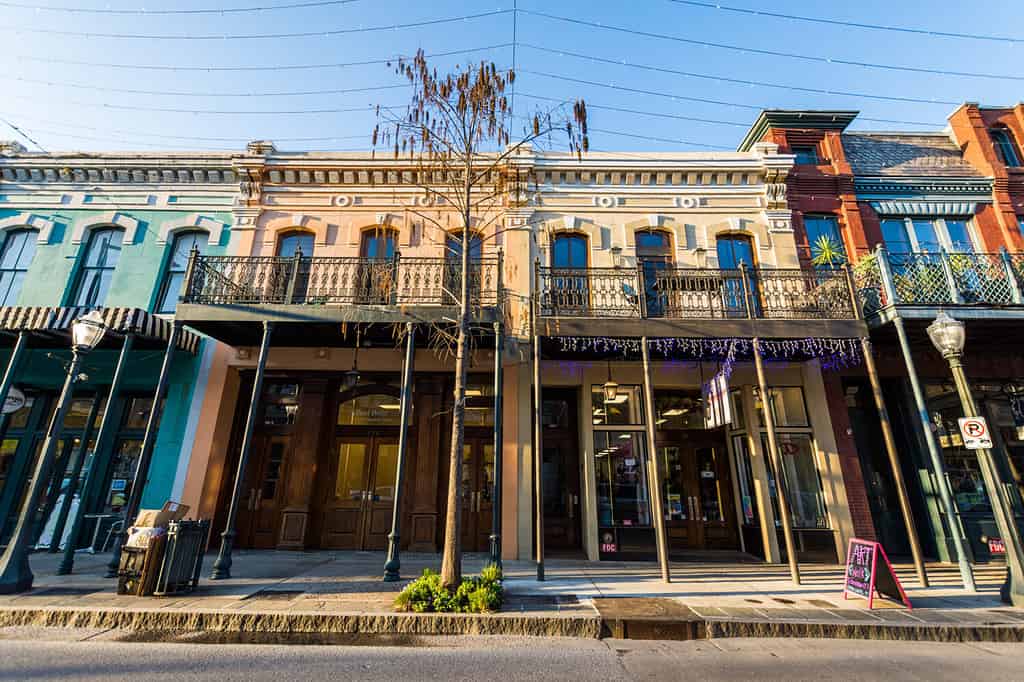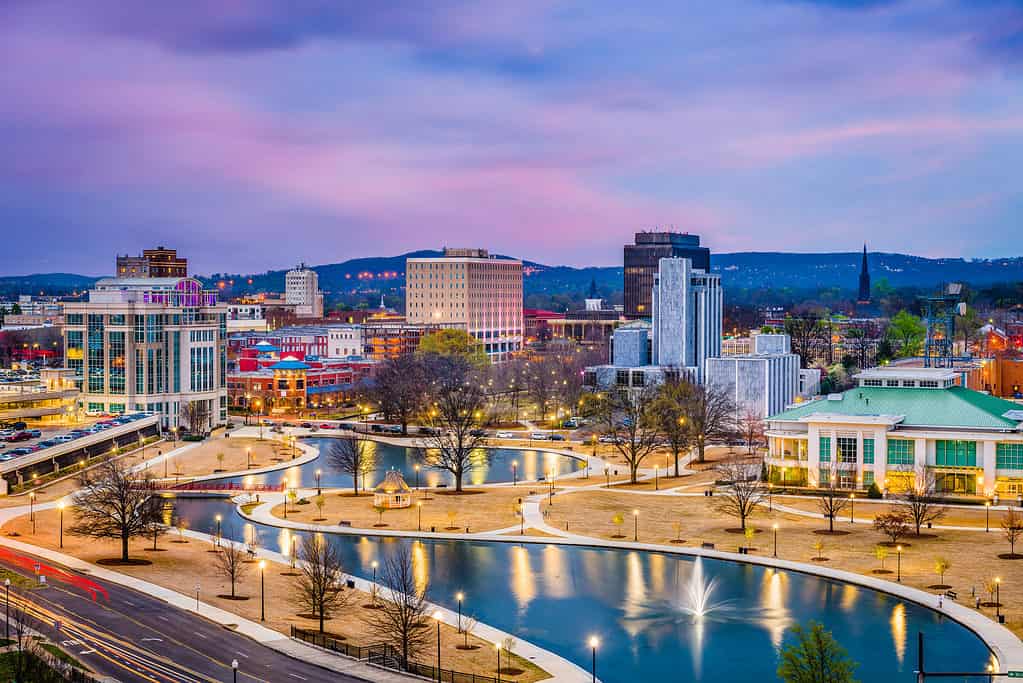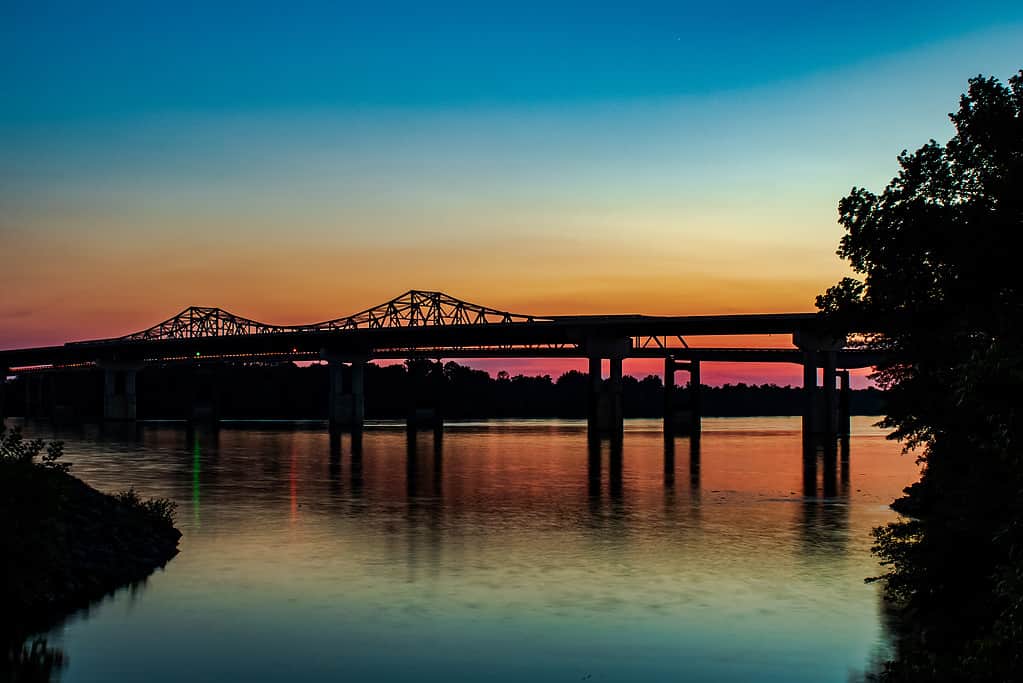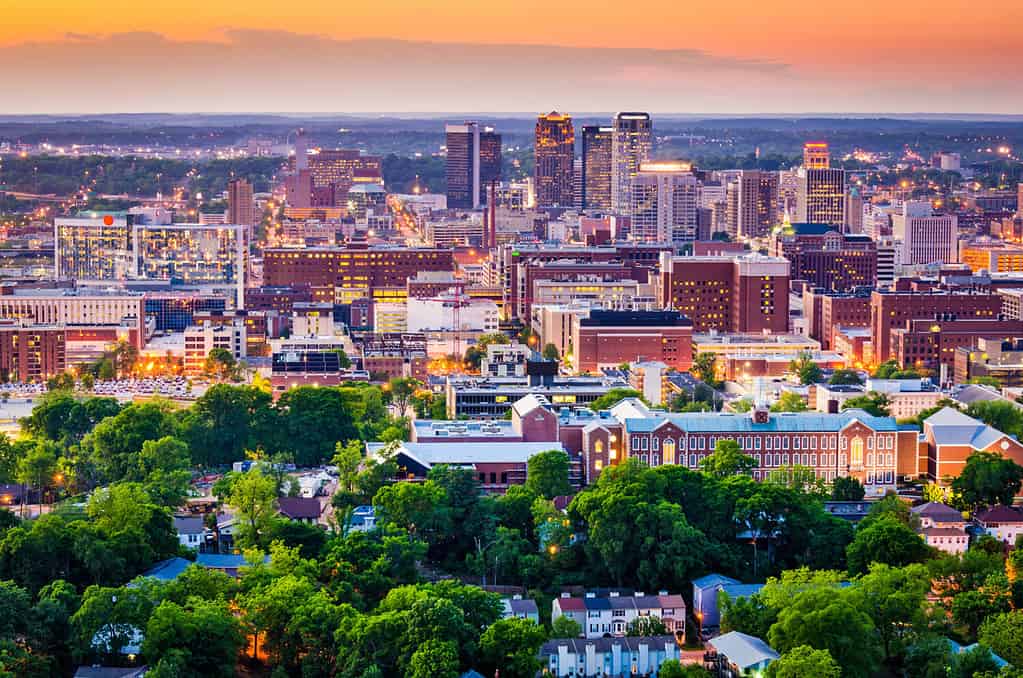Whether you love Alabama for its southern hospitality, beautiful weather, or its low cost of living, there is much to admire about the state. There are many cities that boast lively populations, vast landscapes, and booming industries, but some are particularly noteworthy. In this article, you will discover the largest cities in Alabama based on population, area, and economic impact.
Background
History
Before European colonization of Alabama, many Native American tribes lived in the area. The Cherokee, Muscogee, Shawnee, Choctaw, Creek, and Chickasaw peoples, amongst several more, flourished in the state’s unique environment. Spanish explorers, however, occupied the area in the early 16th century.

Historic downtown Mobile, Alabama has a rich history and continues to thrive today.
©Christian Hinkle/Shutterstock.com
The French gained control in the early 18th century and founded the French capital city of Mobile in 1702. Mobile was a center of trade and cultural exchange. This city retains French influence through the descendants of French colonists that are now known as the Alabama Creoles. Mobile is no longer the capital city, but it is the fourth most populous city in the state. The British gained control over Alabama through the Treaty of Paris in 1763, following the French and Indian War. The region became part of British West Florida and experienced significant migration and settlement by British colonists, primarily from Georgia and the Carolinas.

Alabama became a state in 1819 and adopted its state flag in 1895.
©Mel Mansour/Shutterstock.com
During the American Revolutionary War, Spain captured Mobile in 1780, and the territory fell under Spanish control through the Treaty of Paris in 1783. However, Spain’s rule in Alabama was short-lived, as it ceded the territory back to the United States in 1795 under the Treaty of San Lorenzo. This marked the beginning of Alabama’s transition into becoming part of the growing United States, ultimately leading to its statehood in 1819.
Geography and Ecology
Alabama is in the southeastern United States and borders Tennessee to the north, Georgia to the east, Mississippi to the West, and Florida to the south. Also, part of the state’s southern border is a section of the Gulf of Mexico coastline.

American alligators are among the many animals that live in Alabama’s various ecosystems, including marshes.
©Sorbis/Shutterstock.com
Alabama’s terrain and ecology exhibit highly variable characteristics across its major geographical regions. In the Gulf Coastal Plain, located in the south, one can find sandy beaches, marshes, estuaries, and wetlands that support a rich variety of plant and animal life, including sea turtles, alligators, migratory birds, and fish species. Moving towards central Alabama, the Black Belt Region stands out with its fertile agricultural lands, suitable for growing crops like cotton, soybeans, and peanuts. This region has beautiful hardwood forests and small rivers.

Cheaha Mountain is located in Alabama and is at the tip of the Appalachian Mountain chain.
©iStock.com/JimVallee
In the northeastern part of the state, the Appalachian Plateau showcases its rugged hills, deep valleys, and sandstone ridges, being the southernmost extension of the Appalachian Mountains. The plateau consists of mixed hardwood forests and provides a habitat for wildlife such as deer, wild turkeys, and black bears. Adjacent to the Appalachian Plateau lies the Ridge and Valley Province, characterized by parallel ridges and valleys. This region’s beauty lies in its sandstone, shale, and limestone formations, along with its fertile valleys.
Lastly, the Piedmont Plateau covers a significant portion of central Alabama, featuring rolling hills, mixed pine, and hardwood forests, as well as lakes and rivers. Overall, Alabama is very geographically diverse and ecologically rich due to factors like its Gulf Coast location, the Appalachian Mountains, and distinct geological formations.
Largest City By Population

Huntsville is a bustling city that is home to the most people in Alabama.
©Sean Pavone/Shutterstock.com
The largest city in Alabama by population is Huntsville. The population of Huntsville is 220,854 people! This is followed by Montgomery with a population of 196,010 and Birmingham with 192,557 people. In terms of demographics, Huntsville is a diverse city that is still growing. The city also has a relatively young population. The median age is around 38 years. The racial and ethnic composition of Huntsville is diverse, with a mix of African Americans, Whites, Hispanics, Asians, and other ethnicities.
Over the years, Huntsville has experienced significant population growth, driven largely by its thriving economy, job opportunities, and quality of life. The city’s population has consistently increased since its founding in 1805, but the most notable periods of growth occurred during the 20th and 21st centuries. The development of Redstone Arsenal and NASA’s presence in the 1950s and 1960s played a vital role in attracting highly skilled professionals to the area, causing a population surge. Huntsville’s population continues to increase due to its strong technology and defense industries, as well as its reputation as a hub for research, innovation, and entrepreneurship.
Largest City By Area

Visitors can see a breathtaking sunset over the Tennessee River in Huntsville, Alabama.
©/Shutterstock.com
Interestingly, the largest city in Alabama by area is also Huntsville! Huntsville expands across 209.05 square miles. The next largest city is smaller by a significant margin – Montgomery, Alabama at 159.57 square miles. Third place goes to Birmingham, which is 146.07 square miles.
Huntsville, Alabama boasts a variable and captivating landscape that seamlessly blends natural beauty, urban development, and historical charm. Resting in the foothills of the Appalachian Mountains, rolling hills and valleys encircle the city, offering picturesque views and a serene ambiance. The Tennessee River flows through Huntsville and provides recreational opportunities. Parks and trails along the riverbanks invite residents and visitors to connect with nature and enjoy the waterfront scenery.
Additionally, Huntsville’s historic districts, such as Twickenham, Old Town, and Five Points, showcase well-preserved homes and buildings from the 19th and early 20th centuries. These districts contribute to the city’s unique aesthetic and provide a glimpse into its rich history. With its captivating blend of natural landscapes, urban amenities, and historic charm, Huntsville offers a vibrant and visually appealing environment for its residents and visitors alike.
Largest City By Economic Impact

Birmingham is the financial hub of Alabama.
©Sean Pavone/Shutterstock.com
The most economically impactful city in Alabama is Birmingham. In fact, Birmingham was responsible for 30.9% of Alabama’s gross domestic product in 2011. Also, the county with the greatest per capita income according to the 2020 census is Shelby County, the county Birmingham is in. The second highest per capita income is in Madison County, which includes Huntsville.
Two of the most lucrative industries in Alabama are automotive manufacturing and aerospace and defense. Alabama has a robust automotive manufacturing sector, with major companies like Mercedes-Benz, Honda, and Hyundai having manufacturing facilities in the state. This industry contributes significantly to Alabama’s economy by providing jobs and generating substantial revenue. Birmingham, as a major economic center, does have a presence in the automotive sector with various automotive-related businesses, including dealerships, logistics companies, and supply chain operations.
The aerospace and defense sector is another lucrative industry in Alabama. The state is home to NASA’s Marshall Space Flight Center, the U.S. Army’s Redstone Arsenal, and several aerospace companies. These entities contribute to research, development, and manufacturing in the aerospace and defense sectors. Subsequently, they create high-paying jobs and drive economic growth. While Birmingham is not traditionally known as a hub for aerospace and defense, it still benefits from the industry through indirect activities such as engineering firms, technology companies, and research institutions that support the broader aerospace and defense sector in the state.
The photo featured at the top of this post is © Nagel Photography/Shutterstock.com
Thank you for reading! Have some feedback for us? Contact the AZ Animals editorial team.






